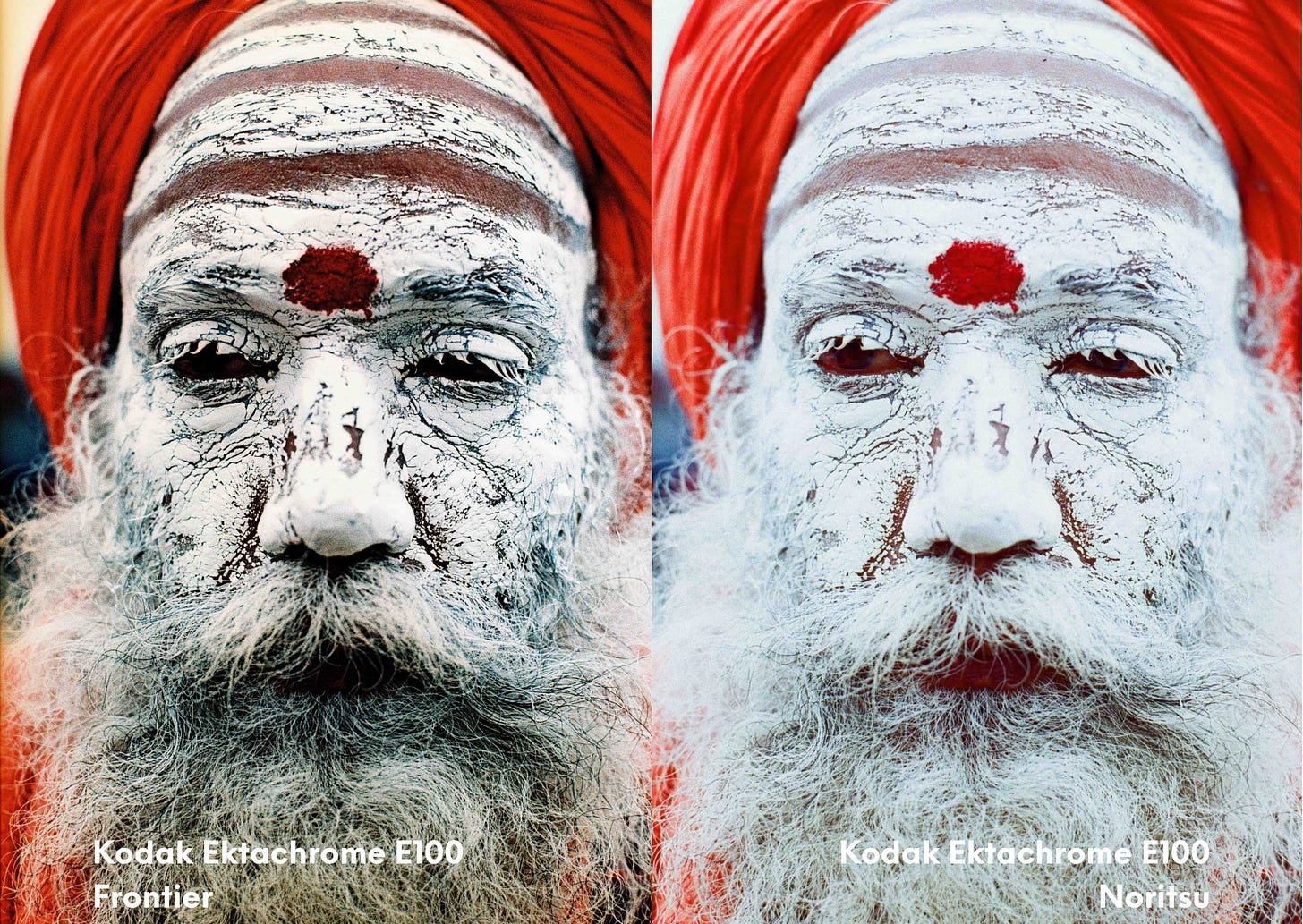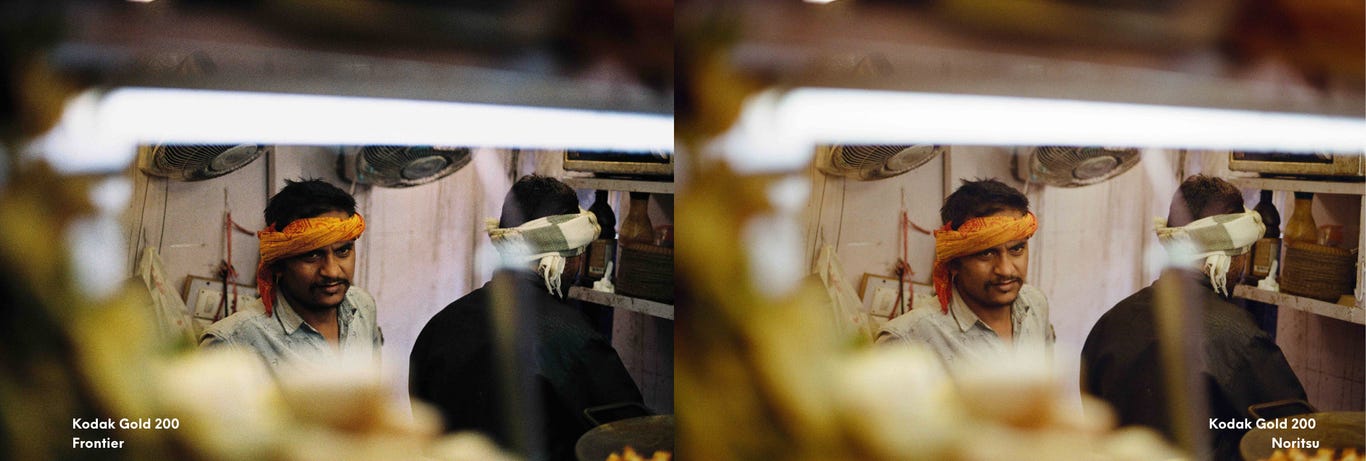The Art of Film Scanning: Frontier vs. Noritsu
I have been shooting film for a few years, experimenting with different cameras, film types, and scanners. It has been an exciting journey of discovery, but until now, I had never directly compared how different scanners interpret the same roll of film.
Curious about this, I traveled to Valencia, Spain, to visit my photography lab—Carmencita. I have worked with them since I first started my analogue journey, and I had always wanted to meet them in person. After all, they are a fundamental part of my workflow—trusted hands that have developed and scanned countless rolls for me over the years. Seeing their process firsthand and understanding the craftsmanship behind each image felt like an essential step in deepening my appreciation for film photography.
This visit provided the perfect opportunity to compare Frontier and Noritsu—two of the most widely used professional film scanners—side by side. Bringing rolls from my recent trip to India, I wanted to see how each scanner would interpret the same negatives, revealing differences in colour, contrast, and overall feel.
The following samples are straight from the scanners, unedited and untouched, offering an honest look at their unique rendering styles.
Kodak Gold 200
The first test was conducted using Kodak Gold 200, a well-known consumer-grade colour negative film, processed in C-41 chemistry to ensure a standardised development workflow. This approach provided a reliable baseline for comparing scanner performance.
Kodak Ektachrome E100
The second test was conducted using Kodak Ektachrome E100, cross-processed in C-41 chemistry. This specialised review examined how each scanner handled the unique colour shifts and contrast variations introduced by cross-processing, offering insights into their adaptability to different film treatments.
Fuji Frontier SP3000: Bold, Vibrant, and High-Contrast Rendering
Frontier is known for its punchy and vivid colour reproduction, adding a distinct character to film scans. It significantly enhances contrast, resulting in images that feel more polished straight out of the scanner. This makes it a popular choice for those who prefer a strong, vibrant look without extensive post-processing.
One of the defining traits of Frontier is its deep black point, which adds richness to shadows and depth to images. However, this can sometimes come at the cost of shadow detail, where darker areas may appear slightly crushed.
In terms of colour, Frontier amplifies saturation, producing intense, eye-catching tones with a noticeable boost in warmth. Skin tones tend to lean toward a golden hue, giving portraits a warm, slightly stylised look. This scanner also enhances overall clarity, making colours feel crisp and well-defined.
For those who enjoy a bold, high-impact aesthetic with rich contrast and vibrant hues, the Frontier delivers a distinctive and polished result, making it a favourite among photographers looking for energetic and visually striking scans.
Noritsu HS-1800: Subtle, Natural, and True-to-Film Rendering
Noritsu takes a more subtle and natural approach to film scanning, offering a softer and less processed rendition of the emulsion. Compared to Frontier, its output feels more muted and true-to-life, making it a preferred choice for those who want to preserve the film’s natural characteristics.
One key distinction of Noritsu is its more neutral black point, which results in a flatter contrast profile. While this means the images might appear less punchy straight out of the scanner, it also allows for greater shadow detail, making subtle tonal variations more visible.
In terms of colour, Noritsu produces softer, lighter hues with a more even distribution of tones. Transitions between highlights, midtones, and shadows feel smoother and more gradual, giving images a realistic and understated look.
Overall, Noritsu is ideal for photographers who prefer a natural and flexible starting point, with gentle colours, smoother gradations, and a true-to-film aesthetic that retains more detail across the tonal range.
Findings
Both Frontier and Noritsu performed well with Kodak Gold 200, though Frontier likely produced stronger, more immediately striking results due to its higher contrast and saturation.
The analysis of Kodak Ektachrome E100, cross-processed in C-41, revealed more distinct differences between the two scanners. Slide films are highly sensitive to exposure, where even slight variations can dramatically affect colour and contrast—factors that also influence how scanners render the final image. While Frontier produced some striking frames, Noritsu generally provided a more balanced and consistent rendering. Its softer, more neutral approach made it better suited for the unpredictable nature of cross-processed slide film.
Each scanner imparts a unique character, much like different film types do. Spending time with the team in Valencia made me realise just how much scanning is not merely a technical step—it is truly an artistic decision.
I left Valencia with more than just the test scan results. I gained a renewed perspective on my post-production approach. Understanding the nuances between scanners will now allow me to be more deliberate in my choices, ensuring that my images convey the mood and aesthetic I aim to achieve.
A special thanks to Albert for the invitation to the lab, to Alex for his invaluable time and the knowledge he generously shared with me, and to the entire team at Carmencita, whose expertise and support made this analysis possible. If you enjoy my film pictures, Carmencita certainly deserves some credit. While I may be the one behind the lens, film photography is more than capturing images—it is a collaborative process. Behind every frame lies the combined expertise, craftsmanship, and dedication of those who develop and scan the film, translating a raw negative into the final image we see.






